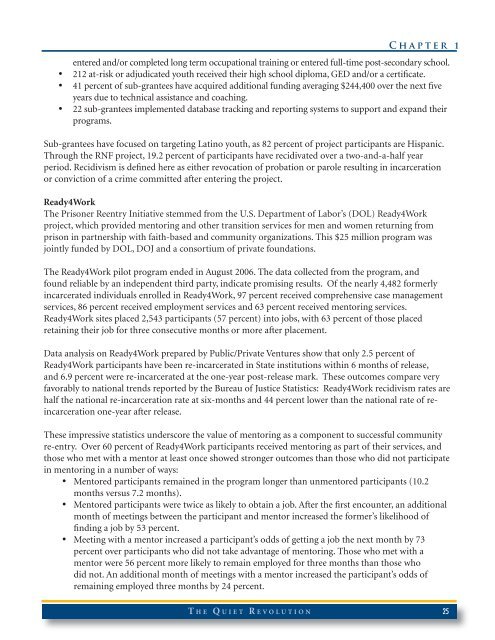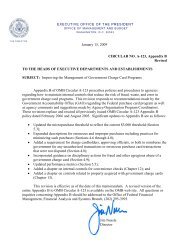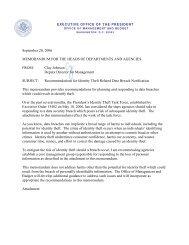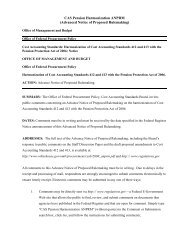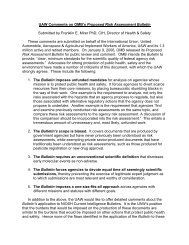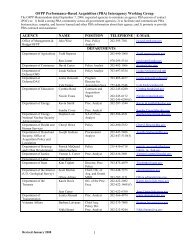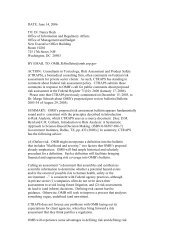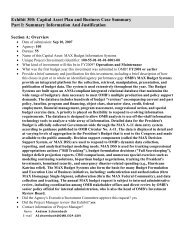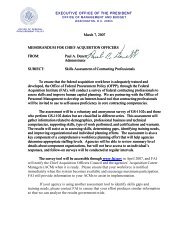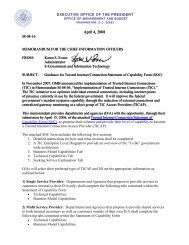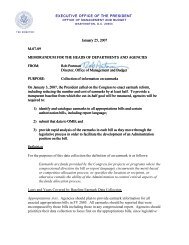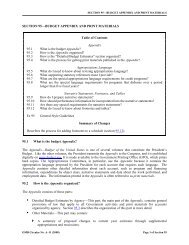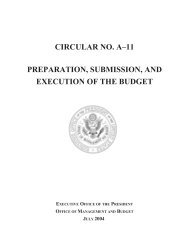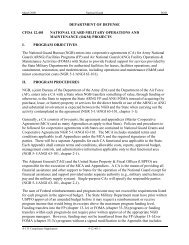The Quiet Revolution (Entire Report in PDF) - the White House
The Quiet Revolution (Entire Report in PDF) - the White House
The Quiet Revolution (Entire Report in PDF) - the White House
You also want an ePaper? Increase the reach of your titles
YUMPU automatically turns print PDFs into web optimized ePapers that Google loves.
C H A P T E R 1<br />
entered and/or completed long term occupational tra<strong>in</strong><strong>in</strong>g or entered full-time post-secondary school.<br />
• 212 at-risk or adju dicated youth received <strong>the</strong>ir high school diploma, GED and/or a certificate.<br />
• 41 percent of sub-grantees have acquired additional fund<strong>in</strong>g averag<strong>in</strong>g $244,400 over <strong>the</strong> next five<br />
years due to technical assistance and coach<strong>in</strong>g.<br />
• 22 sub-grantees imple mented database track<strong>in</strong>g and report<strong>in</strong>g systems to support and expand <strong>the</strong>ir<br />
programs.<br />
Sub-grantees have focused on target <strong>in</strong>g Lat<strong>in</strong>o youth, as 82 percent of project participants are Hispanic.<br />
Through <strong>the</strong> RNF project, 19.2 percent of partici pants have recidivated over a two-and-a-half year<br />
period. Recidivism is def<strong>in</strong>ed here as ei<strong>the</strong>r revocation of probation or parole result<strong>in</strong>g <strong>in</strong> <strong>in</strong>car ceration<br />
or conviction of a crime com mitted after enter<strong>in</strong>g <strong>the</strong> project.<br />
Ready4Work<br />
<strong>The</strong> Prisoner Reentry Initiative stemmed from <strong>the</strong> U.S. Department of Labor’s (DOL) Ready4Work<br />
project, which provided mentor<strong>in</strong>g and o<strong>the</strong>r transition services for men and women return<strong>in</strong>g from<br />
prison <strong>in</strong> partnership with faith-based and community organizations. This $25 million program was<br />
jo<strong>in</strong>tly funded by DOL, DOJ and a consortium of private foundations.<br />
<strong>The</strong> Ready4Work pilot program ended <strong>in</strong> August 2006. <strong>The</strong> data collected from <strong>the</strong> program, and<br />
found reliable by an <strong>in</strong>dependent third party, <strong>in</strong>dicate promis<strong>in</strong>g results. Of <strong>the</strong> nearly 4,482 formerly<br />
<strong>in</strong>carcerated <strong>in</strong>dividuals enrolled <strong>in</strong> Ready4Work, 97 percent received comprehensive case management<br />
services, 86 percent received employment services and 63 percent received mentor<strong>in</strong>g services.<br />
Ready4Work sites placed 2,543 participants (57 percent) <strong>in</strong>to jobs, with 63 percent of those placed<br />
reta<strong>in</strong><strong>in</strong>g <strong>the</strong>ir job for three consecutive months or more after placement.<br />
Data analysis on Ready4Work prepared by Public/Private Ventures show that only 2.5 percent of<br />
Ready4Work participants have been re-<strong>in</strong>carcerated <strong>in</strong> State <strong>in</strong>stitutions with<strong>in</strong> 6 months of release,<br />
and 6.9 percent were re-<strong>in</strong>carcerated at <strong>the</strong> one-year post-release mark. <strong>The</strong>se outcomes compare very<br />
favorably to national trends reported by <strong>the</strong> Bureau of Justice Statistics: Ready4Work recidivism rates are<br />
half <strong>the</strong> national re-<strong>in</strong>carceration rate at six-months and 44 percent lower than <strong>the</strong> national rate of re<strong>in</strong>carceration<br />
one-year after release.<br />
<strong>The</strong>se impressive statistics underscore <strong>the</strong> value of mentor<strong>in</strong>g as a component to successful community<br />
re-entry. Over 60 percent of Ready4Work participants received mentor<strong>in</strong>g as part of <strong>the</strong>ir services, and<br />
those who met with a mentor at least once showed stronger outcomes than those who did not participate<br />
<strong>in</strong> mentor<strong>in</strong>g <strong>in</strong> a number of ways:<br />
• Mentored participants rema<strong>in</strong>ed <strong>in</strong> <strong>the</strong> program longer than unmentored participants (10.2<br />
months versus 7.2 months).<br />
• Mentored participants were twice as likely to obta<strong>in</strong> a job. After <strong>the</strong> first encounter, an additional<br />
month of meet<strong>in</strong>gs between <strong>the</strong> participant and mentor <strong>in</strong>creased <strong>the</strong> former’s likelihood of<br />
f<strong>in</strong>d<strong>in</strong>g a job by 53 percent.<br />
• Meet<strong>in</strong>g with a mentor <strong>in</strong>creased a participant’s odds of gett<strong>in</strong>g a job <strong>the</strong> next month by 73<br />
percent over participants who did not take advantage of mentor<strong>in</strong>g. Those who met with a<br />
mentor were 56 percent more likely to rema<strong>in</strong> employed for three months than those who<br />
did not. An additional month of meet<strong>in</strong>gs with a mentor <strong>in</strong>creased <strong>the</strong> participant’s odds of<br />
rema<strong>in</strong><strong>in</strong>g employed three months by 24 percent.<br />
T H E Q U I E T R E V O L U T I O N<br />
25


